Groundwater Recharge Estimation Based on Environmental Isotopes, Chloride Mass Balance and SWAT Model in Arid Lands, Southwestern Saudi Arabia
Abstract
1. Introduction
2. Study Area
3. Data Sources and Methods
- Making an inventory of the existing groundwater wells tapping to the coastal aquifer using portable Magellan GPS 315 (San Dimas, CA, USA), as shown in Figure 1. Measuring the depth to water and collecting representative groundwater samples for chemical and isotope analyses.
- Measuring the physical properties of the collected water samples in situ, such as pH, EC (μS/cm at 25 °C), and TDS (mg/L).
- Collecting all the former research and data about rainfall, geology, and hydrogeology, as well as the modern techniques, which can be applied for estimating groundwater recharge rate.
- Chemical analyses of 78 water samples, which included the major cations (Ca2+, Mg2+, Na+, and K+) and anions (SO42−, Cl−, CO3−2, and HCO3−), in addition to the some minor and trace elements, through standard methods (APHA reference). The Ca2+ and Mg2+ levels were quantified using titration, while (Na+) and (K+) were analyzed using flame photometry (Jenway, Models PFP7, Cole-Parmer Ltd., Staffordshire, UK). The Cl− level was determined by titration with code chloride 9253 and a solution of silver nitrate (AgNO3), while the SO42− levels were measured using turbidity with a spectrophotometer. The CO3 and HCO3 levels were estimated using titration against 0.01 N H2SO4 using phenolphthalein and methyl orange indicators. The I− and Br−, levels were measured using ion chromatography (ICS-1100 systems, Ramsey, MN, USA). The ion balance error between total cations and anions was calculated, which was less than 5%, supporting the reliability of the results and the accuracy of the lab used for analysis of groundwater samples. In addition, environmentally stable isotopes including deuterium (2H) and oxygen-18 (18O) were determined for 29 representative groundwater samples using a PICARRO L2130-i high precision isotopic analyzer by the Hydrogeology Group, Institute of Geological Sciences—Frei University Berlin— Germany.
- Analyzing the frequency of maximum daily rainfall occurrences and applying common probability distribution functions to fit the actual data.
- Using a soil and water assessment tool (SWAT) model for recharge estimation, which depends upon many parameters, for instance hydro-meteorological data, land uses and covers, digital elevation models (DEMs), soils, groundwater levels, watershed delineations, calibration and validations of the results, and spatial and temporal simulation of groundwater recharge. The parameters for input and output related to the groundwater recharge evaluation utilizing the SWAT model are illustrated in Figure 4.
- Use of GIS, hydrogeological data, and chemical analysis for data digitization for the study area.
- Providing the necessary recommendations that might help decision-makers with sustainable water resource management in the study area.
4. Results and Discussion
4.1. Water Resources
4.1.1. Groundwater Quality of the Coastal Aquifer
- Sea water intrusion
4.1.2. Mechanism of Groundwater Recharge
4.1.3. Estimation of Groundwater Recharge
- Chloride mass balance (CMB) method
- Soil and water assessment tool (SWAT) model
5. Conclusions
- Increasing the Hydrological and Chemical Monitoring Network.
- Investigating secondary chloride sources.
- Enhancing geological and hydrogeological data input.
- Studying the impact of land use change.
- Establishing an integrated database.
Author Contributions
Funding
Institutional Review Board Statement
Informed Consent Statement
Data Availability Statement
Conflicts of Interest
References
- Amin, M.; Ashraf, M. The challenges and potential strategies of Saudi Arabia’s water Resources: A review in analytical way. Environ. Nanotechnol. Monit. Manag. 2023, 20, 100855. [Google Scholar] [CrossRef]
- Eagleson, P.S. The annual water balance. J. Hydraul. Div. 1979, 105, 921–941. [Google Scholar] [CrossRef]
- Lerner, D.N.; Issar, A.S.; Simmers, I. Groundwater Recharge: A Guide to Understanding and Estimating Natural Recharge; IAH International Contributions to Hydrogeology; Taylor and Francis: New York, NY, USA; Balkema: Rotterdam, The Netherlands, 1990. [Google Scholar]
- Flint, A.L.; Flint, L.E.; Kwicklis, E.M.; Fabryka-Martin, J.T.; Bodvarsson, G.S. Estimating recharge at Yucca Mountain, Nevada, USA: Comparison of methods. Hydrogeol. J. 2002, 10, 180–204. [Google Scholar] [CrossRef]
- Edmunds, W.; Fellman, E.; Goni, I.; Prudhomme, C. Spatial and temporal distribution of groundwater recharge in northern Nigeria. Hydrogeol. J. 2002, 10, 205–215. [Google Scholar] [CrossRef]
- Carter, R.; Morgulis, E.; Dottridge, J.; Agbo, J. Groundwater modelling with limited data: A case study in a semi-arid dunefield of northeast Nigeria. Q. J. Eng. Geol. Hydrogeol. 1994, 27, S85–S94. [Google Scholar] [CrossRef]
- Fritz, P.; Fontes, J.C. The Terrestrial Environment A. In Handbook of Environmental Isotope Geochemistry; Elsevier: Amsterdam, The Netherlands, 1980; Volume 1. [Google Scholar]
- Wood, W.W.; Imes, J.L. How wet is wet? Precipitation constrains on late Quaternary climate in southern Arabian Peninsula. J. Hydrol. 1995, 164, 263–268. [Google Scholar] [CrossRef]
- Wood, W.W.; Sanford, W.L. Chemical and isotopic methods for quantifying groundwater recharge in a regional, semi-arid environment. Ground Water 1995, 33, 458–468. [Google Scholar] [CrossRef]
- Wood, W.W. Use and Misuse of the Chloride-Mass Balance Method in Estimating Ground Water Recharge. Ground Water 1999, 37, 2–3. [Google Scholar] [CrossRef]
- Shi, J.; Wang, Q.; Chen, G.; Wang, G.; Zhang, Z. Isotopic geochemistry of the groundwater system in arid and semiarid areas and its significance: A case study in Shiyang River basin, Gansu province, northwest China. Environ. Geol. 2001, 40, 557–565. [Google Scholar] [CrossRef]
- Kattan, Z. Use of hydrochemistry and environmental isotopes for evaluation of groundwater in the Paleogene limestone aquifer of the Ras Al-Ain area (Syrian Jezireh). Environ. Geol. 2001, 41, 128–144. [Google Scholar] [CrossRef]
- International Atomic Energy Agency. Atomic Energy Review; No. 1; IAEA: Vienna, Austria, 1980; Volume 18. [Google Scholar]
- International Atomic Energy Agency. Nuclear Power Reactors in the World September; 1983 ed.; Reference Data Series No. 2; IAEA: Vienna, Austria, 1983. [Google Scholar]
- Clark, I.; Fritz, P.F. Environmental Isotopes in Hydrology; Lewis Publishers: Boca Raton, FL, USA, 1998. [Google Scholar] [CrossRef]
- Uugulu, S.; Wanke, H. Estimation of groundwater recharge in savannah aquifers along a precipitation gradient using chloride mass balance method and environmental isotopes, Namibia. Phys. Chem. Earth Parts A/B/C 2020, 116, 102844. [Google Scholar] [CrossRef]
- Abdulrazzak, M.; Şorman, Ü.; El-Hames, A. Water balance approach under extreme arid conditions—A case study of Tabalah Basin, Saudi Arabia. Hydrol. Process 1989, 3, 107–122. [Google Scholar] [CrossRef]
- Bazuhair, A.S.; Wood, W. Chloride mass-balance method for estimating ground water recharge in arid areas: Examples from western Saudi Arabia. J. Hydrol. 1996, 186, 153–159. [Google Scholar] [CrossRef]
- Bazuhair, A.S.; Nassief, M.O.; Al-Yamani, M.S.; Sharaf, M.A.; Bayumi, T.H.; Ali, S. Groundwater Recharge Estimation in Some Wadi Aquifers of the Western Saudi Arabia: King Abdulaziz City for Science and Technology; Project No. AT-17–63; CRC Press: Riyadh, Saudi Arabia, 2002. [Google Scholar]
- Alshehri, F.; Mohamed, A. Investigation of groundwater potential using gravity data in Wadi Fatimah and its surroundings, Western Saudi Arabia. Front. Earth Sci. 2023, 11, 1225992. [Google Scholar] [CrossRef]
- Alshehri, F.; Abdelrahman, K. Groundwater Potentiality of Wadi Fatimah, Western Saudi Arabia: Geophysical and Remote Sensing Integrated Approach. Water 2023, 15, 1828. [Google Scholar] [CrossRef]
- Alshehri, F.; Sultan, M.; Karki, S.; Alwagdani, E.; Alsefry, S.; Alharbi, H.; Sahour, H.; Sturchio, N. Mapping the distribution of shallow groundwater occurrences using Remote Sensing-based statistical modeling over southwest Saudi Arabia. Remote Sens. 2020, 12, 1361. [Google Scholar] [CrossRef]
- Mallick, J.; Singh, C.K.; AlMesfer, M.K.; Singh, V.P.; Alsubih, M. Groundwater Quality Studies in the Kingdom of Saudi Arabia: Prevalent Research and Management Dimensions. Water 2021, 13, 1266. [Google Scholar] [CrossRef]
- Masoud, M.H.Z.; Rajmohan, N.; Basahi, J.M.; Niyazi, B.A.M. Application of water quality indices and health risk models in the arid coastal aquifer, Southern Saudi Arabia. Environ. Sci. Pollut. Res. 2022, 29, 70493–70507. [Google Scholar] [CrossRef]
- Aly, A.A.; Al-Omran, A.M.; Alharby, M.M. The water quality index and hydrochemical characterization of groundwater resources in Hafar Albatin, Saudi Arabia. Arab. J. Geosci. 2015, 8, 4177–4190. [Google Scholar] [CrossRef]
- Al-Harbi, O.A.; Hussain, G.; Lafouza, O. Irrigation water quality evaluation of Al-Mendasah groundwater and drainage water, Al-Madenah Al-Monawarah region, Saudi Arabia. Int. J. Soil Sci. 2010, 5, 282–300. [Google Scholar] [CrossRef]
- Shereif, H.M. Delineation of potential sites for groundwater recharge using a GIS-based decision support system. Environ. Earth Sci. 2014, 72, 3429–3442. [Google Scholar] [CrossRef]
- Masoud, M.; El Osta, M.; Al-Amri, N.; Niyazi, B.; Alqarawy, A.; Rashed, M. Groundwater Characteristics’ Assessment for Productivity Planning in Al-Madinah Al-Munawarah Province, KSA. Hydrology 2024, 11, 99. [Google Scholar] [CrossRef]
- El Maghraby, M.; Bamousa, A.O. Evaluation of groundwater quality for drinking and irrigation purposes using physicochemical parameters at Salilah area, Madinah Munawarah District, Saudi Arabia. J. Taibah Univ. Sci. 2021, 15, 695–709. [Google Scholar] [CrossRef]
- Hussain, S.; Niyazi, B.; Elfeki, A.M.; Masoud, M.; Wang, X.; Awais, M. SWAT-Driven Exploration of Runoff Dynamics in Hyper-Arid Region, Saudi Arabia: Implications for Hydrological Understanding. Water 2024, 16, 2043. [Google Scholar] [CrossRef]
- Abdalla, F.; Al-Turki, A.; Al Amri, A. Evaluation of groundwater resources in the Southern Tihama plain, Saudi Arabia. Arab. J. Geosci. 2015, 8, 3299–3310. [Google Scholar] [CrossRef]
- Khan, M.Y.A.; ElKashouty, M.; Subyani, A.M.; Tian, F.; Gusti, W. GIS and RS intelligence in delineating the groundwater potential zones in Arid Regions: A case study of southern Aseer, southwestern Saudi Arabia. Appl. Water Sci. 2022, 12, 3. [Google Scholar] [CrossRef]
- El Osta, M.; Masoud, M.; Al-Amri, N.; Alqarawy, A.; Halawani, R.; Rashed, M. Estimation of groundwater recharge by chloride mass balance (CMB) method in some selected wadis, Western Saudi Arabia in (1966–2018). Environ. Earth Sci. 2025, 84, 321. [Google Scholar] [CrossRef]
- Hassan, I.; Salamah, S.; Bob, M. Shallow water table rise and fluctuation between 1977 and 2010 in Madinah City, Saudi Arabia. Discov. Environ. 2024, 2, 88. [Google Scholar] [CrossRef]
- Masoud, M.; El Osta, M.; Al-Amri, N.; Niyazi, B.; Alqarawy, A.; Halawani, R.; Rashed, M. Groundwater Recharge Evaluation Using Stable Isotopes and the NETPATH Model in Al-Madinah Al-Munawarah Province, Saudi Arabia. Water 2025, 17, 211. [Google Scholar] [CrossRef]
- Masoud, M.; El Osta, M.; Alqarawy, A.; Izzeldin, H. Application of Environmental Isotopes and Hydrochemistry to Identify the Groundwater Recharge in Wadi Qanunah Basin, Saudi Arabia. Sustainability 2023, 15, 2648. [Google Scholar] [CrossRef]
- Al-Turki, S. Water Resources in Saudi Arabia with Particular Reference to Tihama Asir Province. Ph.D. Thesis, Department of Geography, University of Durham, Durham, UK, 1995; 612p. Available online: http://core.kmi.open.ac.uk/download/pdf/9640285.pdf (accessed on 23 December 2013).
- Basahel, A.; Bahafzalla, A.; Mansour, H.; Omara, S. Primary structures and depositional environments of the Haddat Ash Sham sedimentary sequence, northwest of Jeddah, Saudi Arabia. Arab Gulf J. Sci. Res. 1983, 1, 143–155. [Google Scholar]
- Kinzelbach, W.; Aeschbach, W.; Alberich, C.; Goni, I.B.; Beyerle, U.; Brunner, P.; Chiang, W.H.; Rueedi, J.; Zoellmann, K. A Survey of Methods for Groundwater Recharge in Arid and Semiarid Regions; Early Warning and Assessment Report Series; UNEP/DEWA/RS.02–2; United Nations Environment Program: Nairobi, Kenya, 2002. [Google Scholar]
- Japan International Cooperation Agency, JICA. Chapter 4: Water Resources Potential. In The Study on Master Plan on Renewable Water Resources Development in the Southwest Region in the Kingdom of Saudi Arabia; Yachiyo Engineering Co., Ltd.: Tokyo, Japan, 2010; pp. S-4-1–S-7-3. [Google Scholar]
- Scanlon, R.; Healy, R.W.; Cook, P.G. Choosing appropriate techniques for quantifying groundwater recharge. Hydrogeol. J. 2002, 10, 18–39. [Google Scholar] [CrossRef]
- Erikson, E.H. The Distribution of Salinity in the Groundwater of Delhi Origin and Recharge Rates of Groundwater; IAEA: Vienna, Austria, 1975; pp. 171–177. [Google Scholar]
- Glenn, T. An Introduction to Climate, 3rd ed.; McGraw-Hill: New York, NY, USA, 1954. [Google Scholar]
- Mahmoodi, N.; Wagner, D.P.; Kiesel, J.; Fohrer, N. Modeling the impact of climate change on stream flow and major hydrological components of an Iranian Wadi system. J. Water Clim. Change 2021, 12, 1598–1613. [Google Scholar] [CrossRef]
- Allison, G.B.; Gee, G.W.; Tyler, S.W. Vadoze-zone Techniques for estimating groundwater recharge in arid and semi-arid regions. Soil Sci. Soc. Am. J. 1994, 58, 6–14. [Google Scholar] [CrossRef]
- Chebotarev, I.I. Metamorphism of natural waters in the crust of weathering. Geochim. Cosmochim. Acta 1955, 8, 22–32, IN1–IN2, 33–48. [Google Scholar] [CrossRef]
- Piper, A.M. A graphic procedure in the geochemical interpretation of water-analyses. EOS Trans. Am. Geophys. Union 1944, 25, 914–928. [Google Scholar]
- Yu, I.; Massoudieh, A.; Green, C.T.; Lee, K.-L.; Kaown, D. Complexity of groundwater age mixing near a seawater intrusion zone based on multiple tracers and Bayesian inference. Sci. Total Environ. 2021, 753, 141994. [Google Scholar] [CrossRef]
- Craig, H. Isotopic variations in meteoric waters. Science 1961, 133, 1702–1703. [Google Scholar] [CrossRef]
- Al-Harbi, O.A.; Ghulam Hussain, G.H.; Khan, M.M.; Moallim, M.A.; Al-Sagaby, I.A. Evaluation of Groundwater Quality and its Recharge by Isotopes and Solute Chemistry in Wadi Malal, Al-Madinah Al-Munawarah, Saudi Arabia. Pak. J. Biol. Sci. 2006, 9, 260–269. [Google Scholar] [CrossRef]
- Michelsen, N.; Reshid, M.; Siebert, C.; Schulz, S.; Knöller, K.; Weise, S.M.; Rausch, R.; Al-Saud, M.; Schüth, C. Isotopic and chemical composition of precipitation in Riyadh, Saudi Arabia. Chem. Geol. 2015, 413, 51–62. [Google Scholar] [CrossRef]
- Simmons, C.T.; Hong, H.; Wye, D.; Cook, P.G.; Love, A.J. Signal propagation and periodic response in aquifers: The effect of fractures and signal measurement methods. In Water 99 Joint Congress; Institution of Engineers: Barton, ACT, Australia, 1999; pp. 727–732. [Google Scholar]
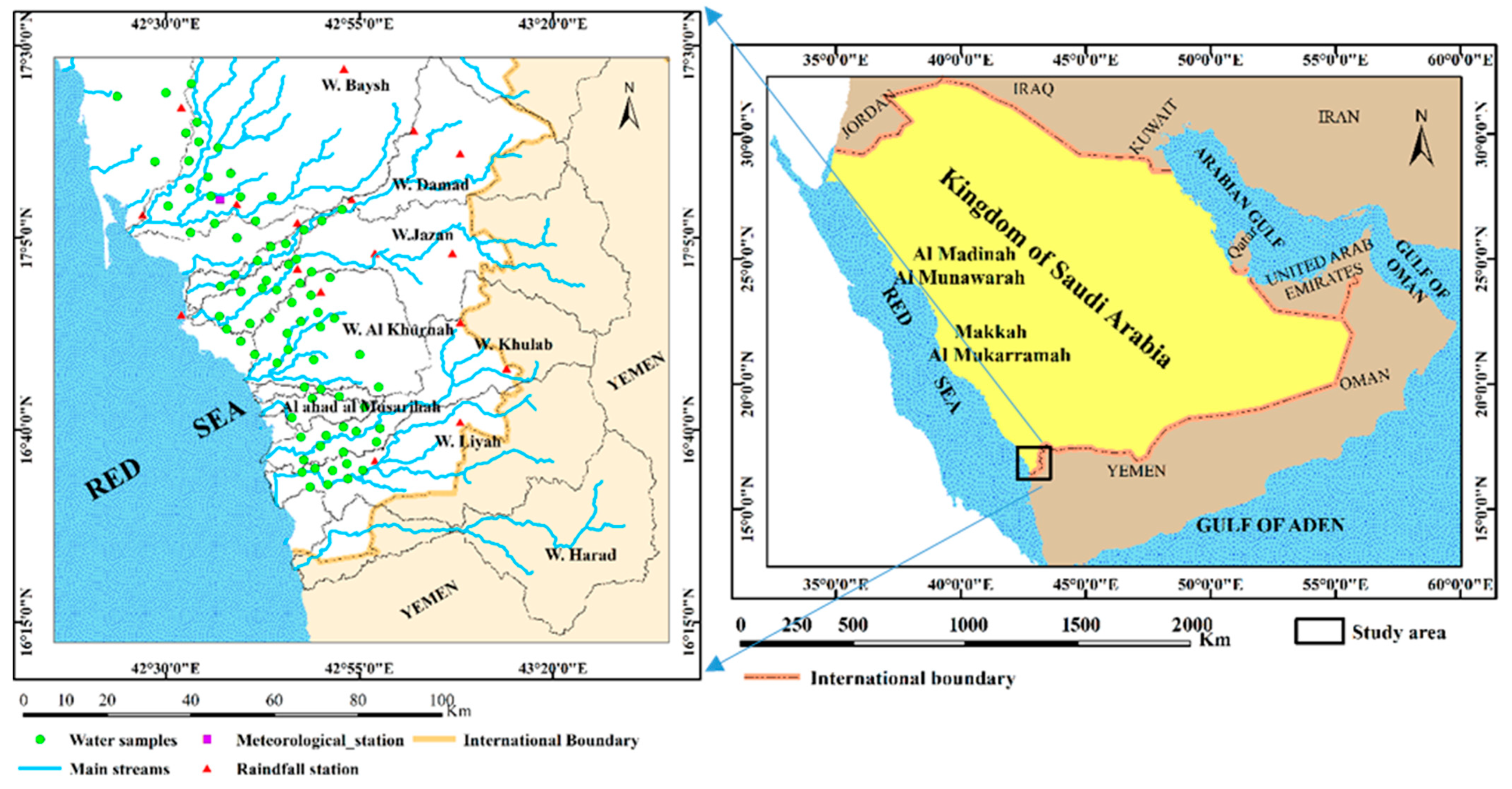
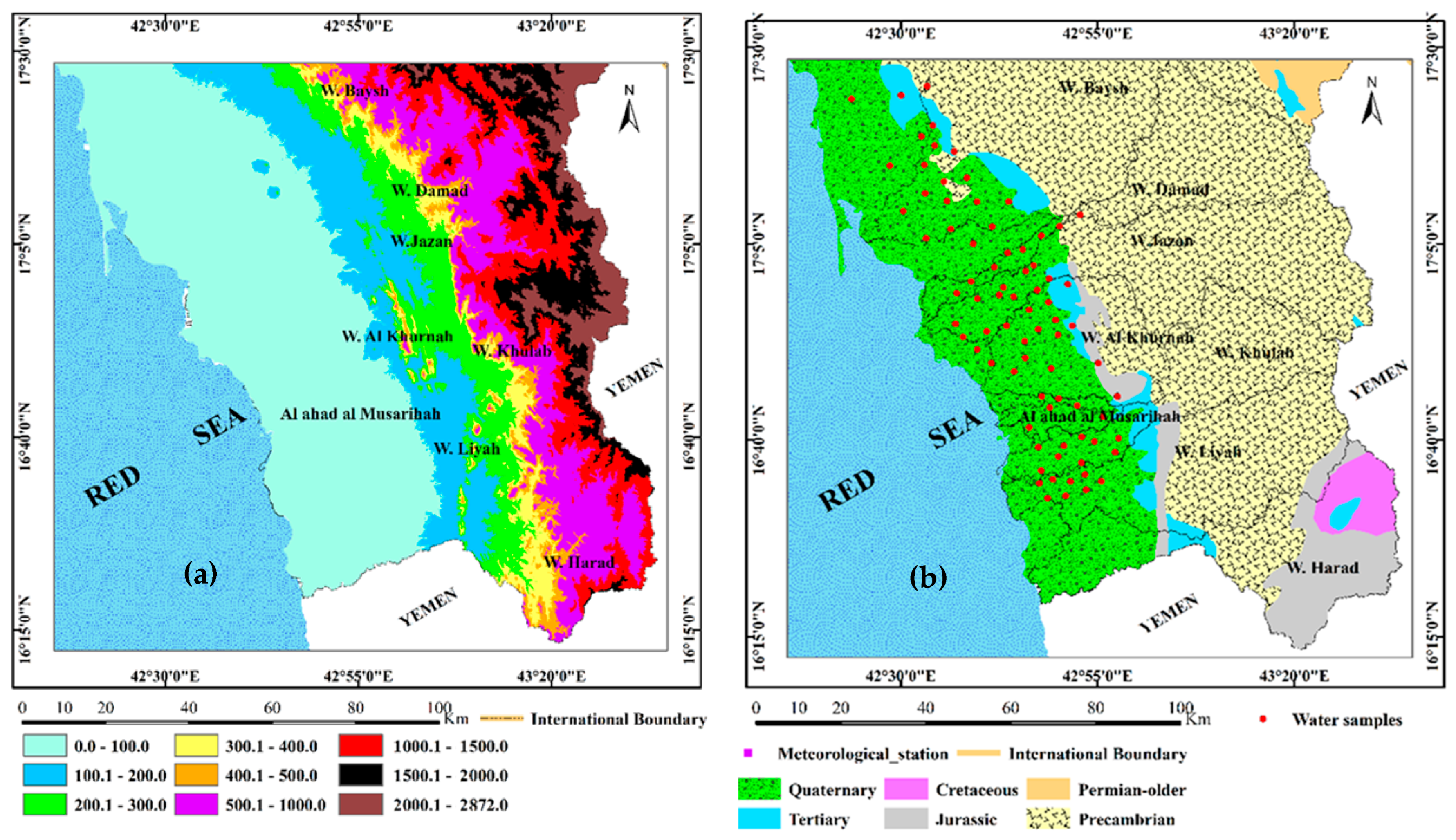

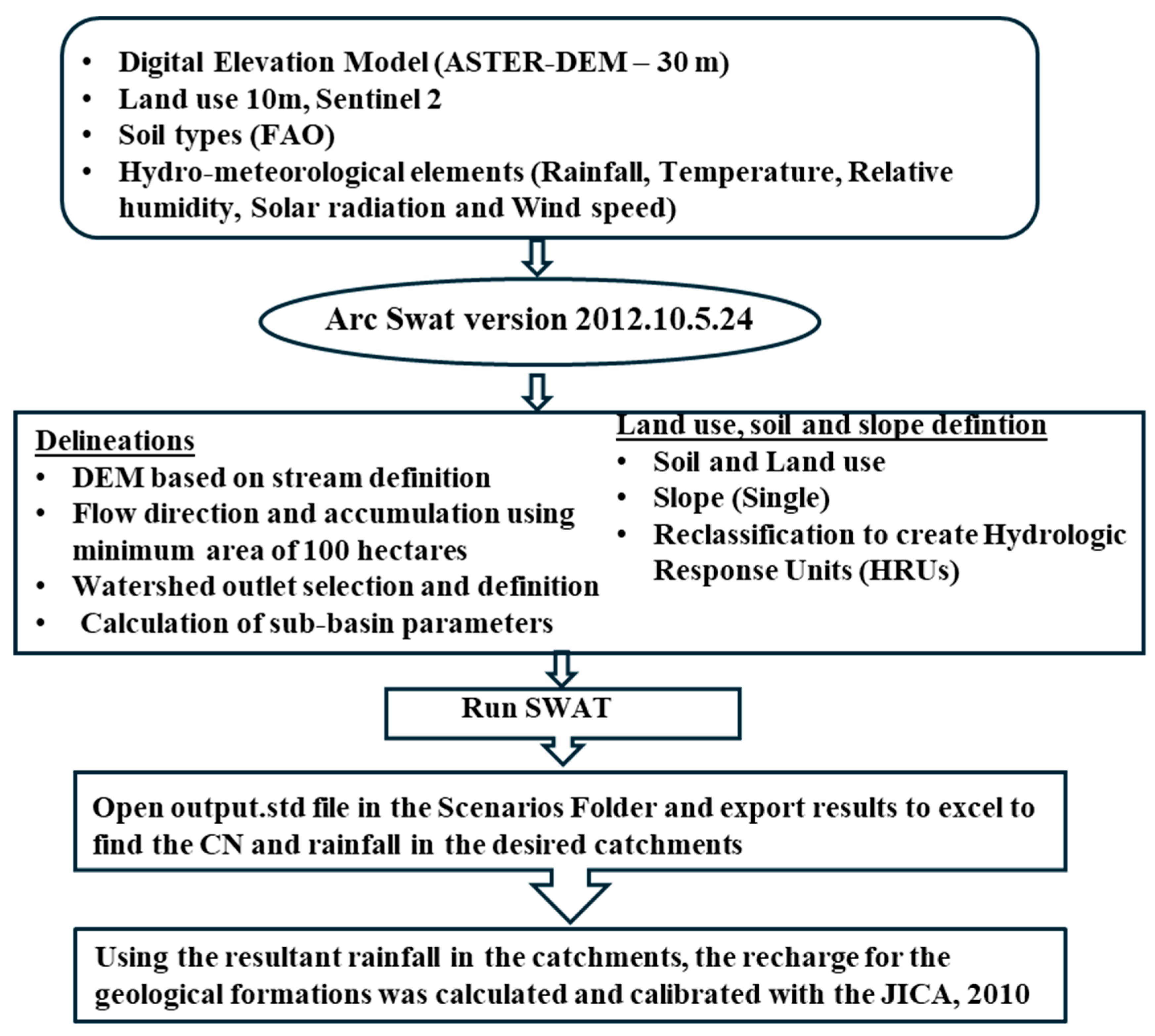

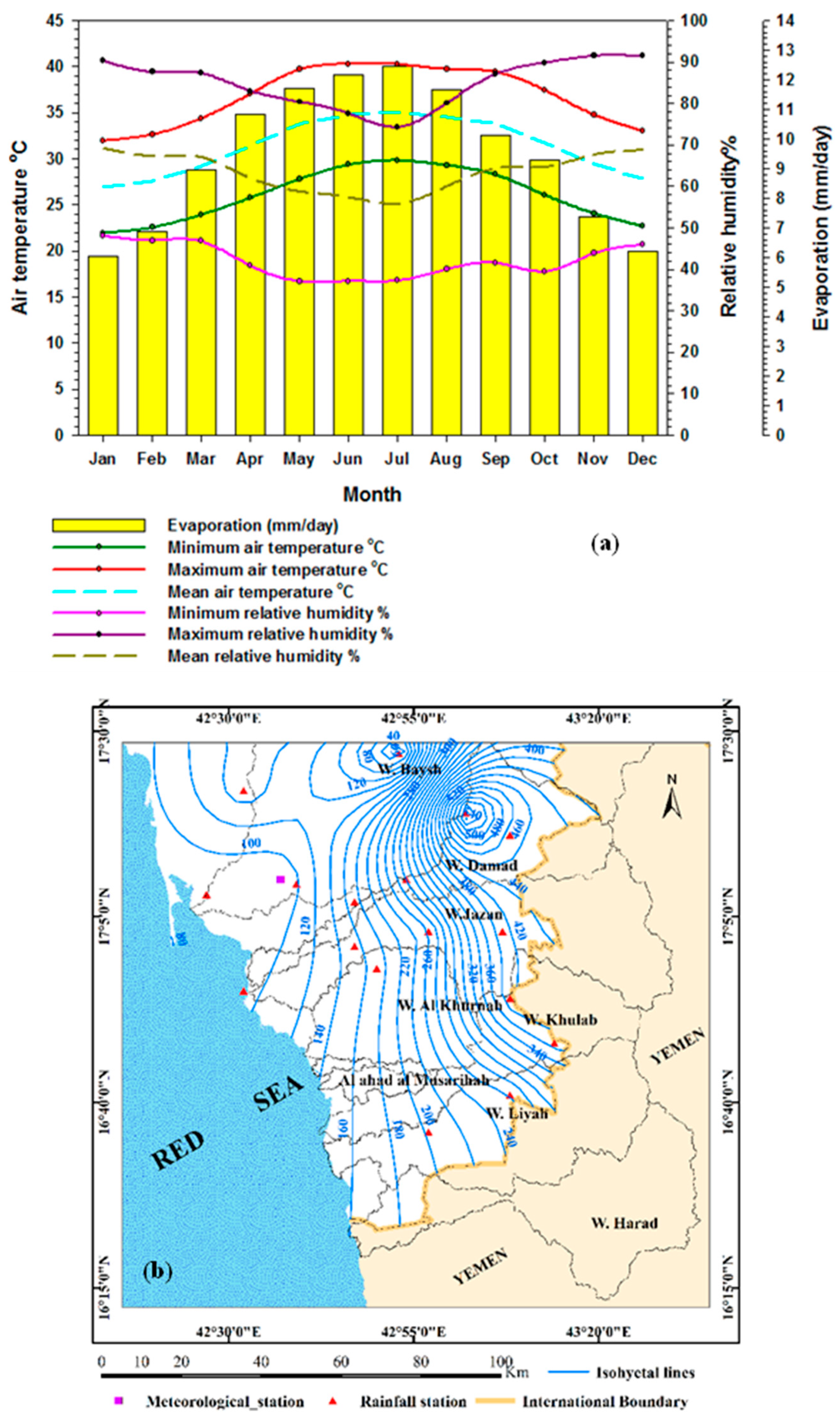
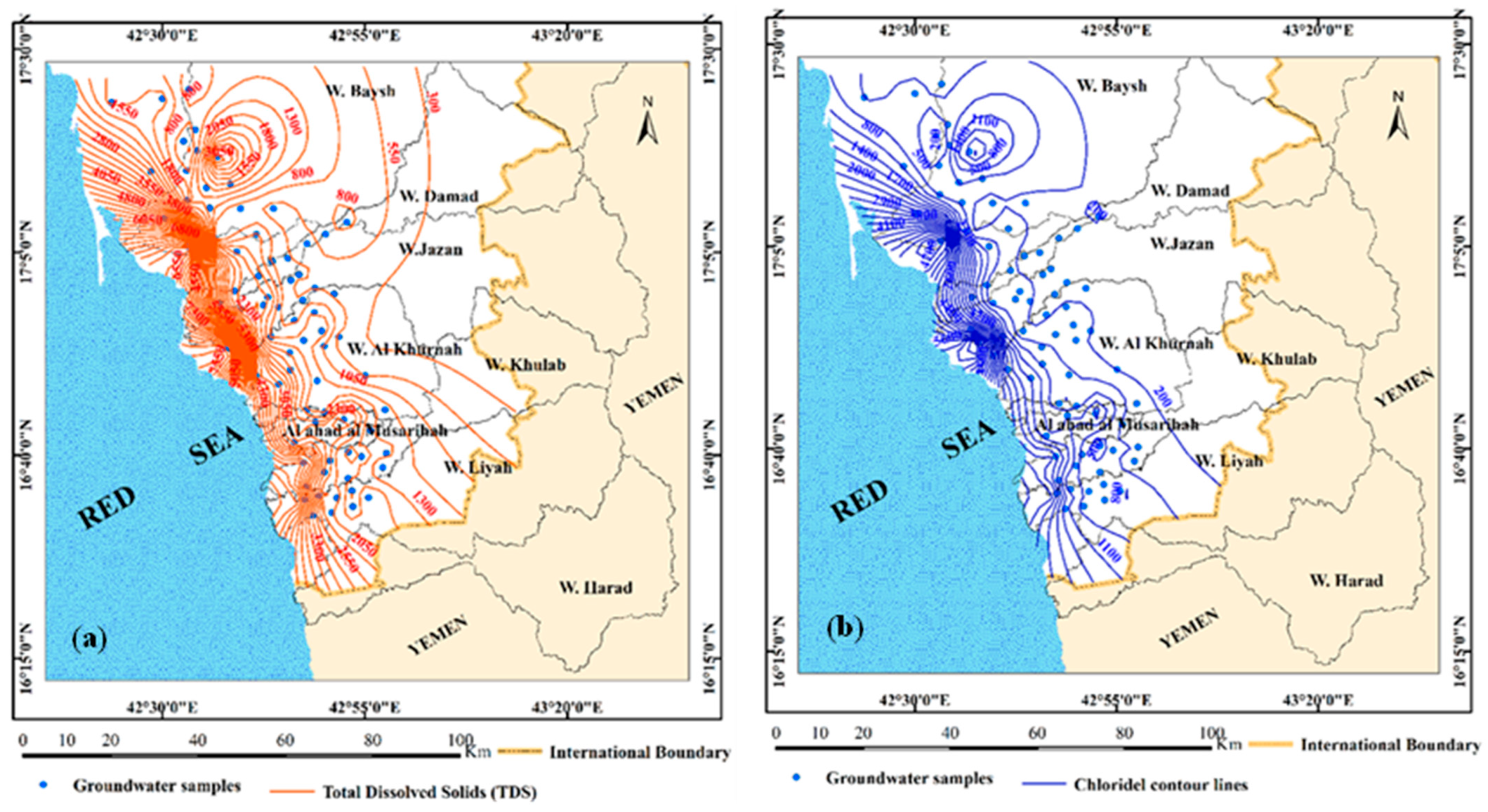


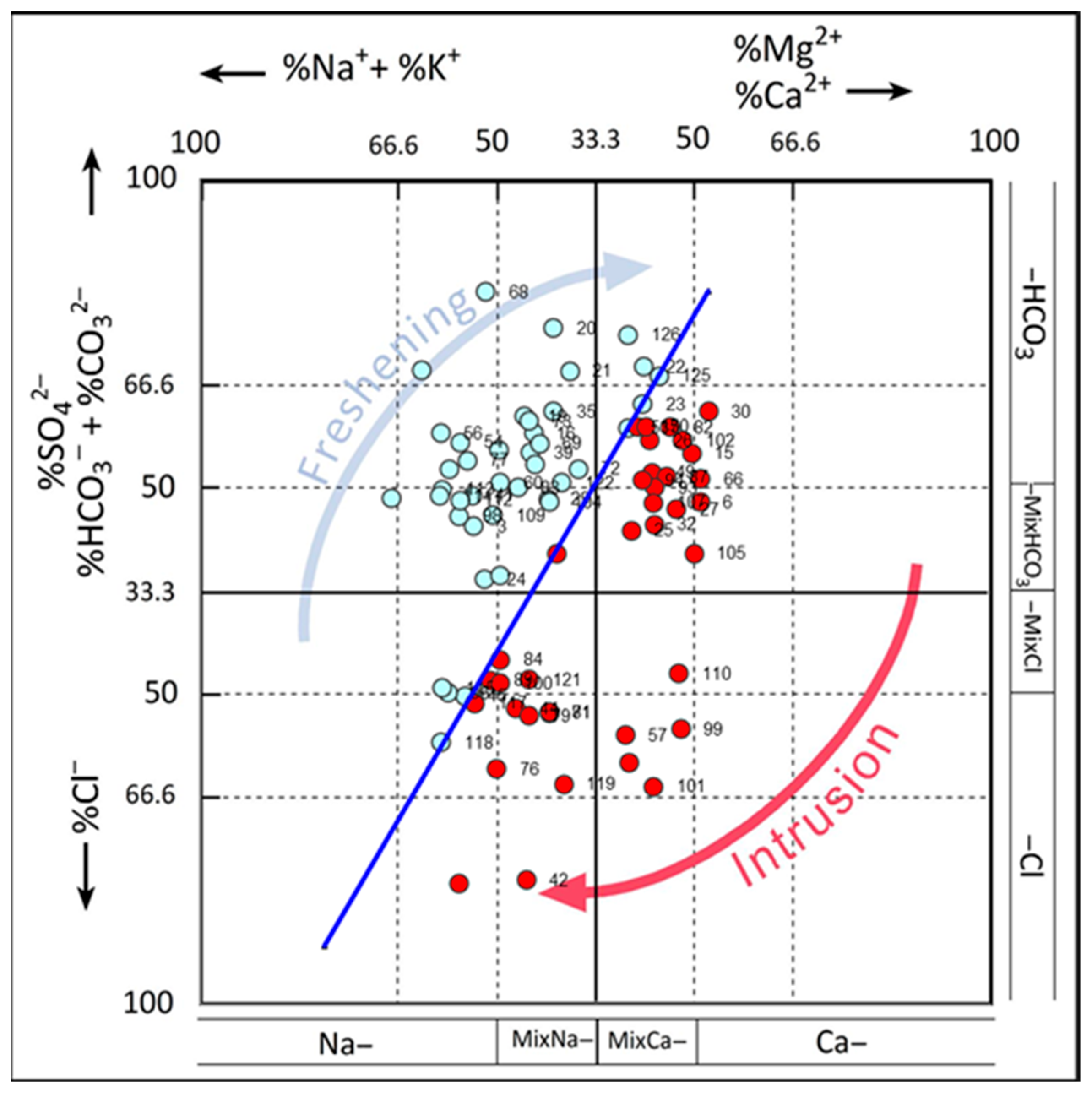

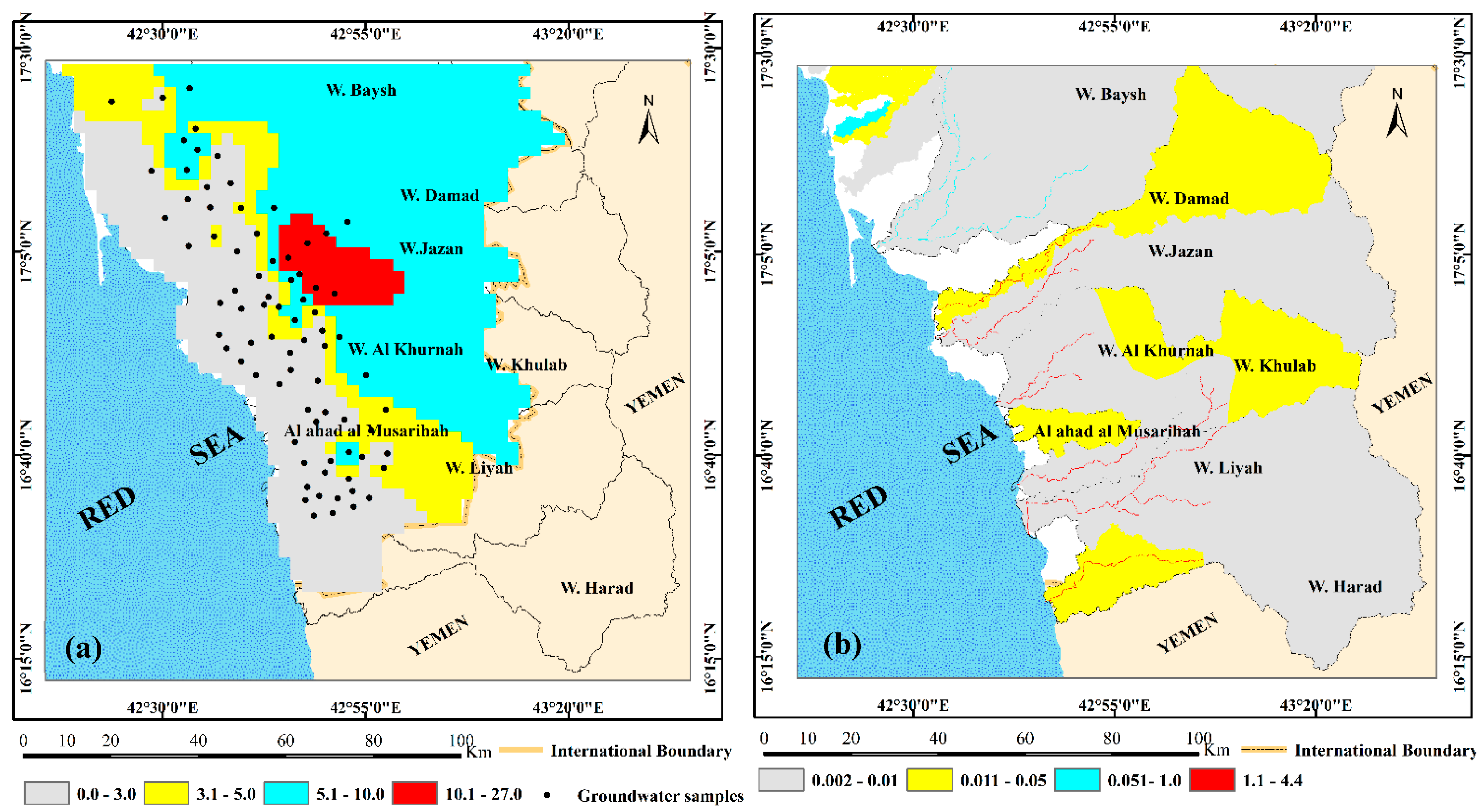
| Physicochemical Parameters | (Number of Groundwater Samples = 78) | Rainwater Sample | ||
|---|---|---|---|---|
| Unit | Minimum | Maximum | ||
| pH | - | 6.2 | 7.6 | 6.94 |
| EC | µS/cm | 1082 | 23,840 | 130.00 |
| TDS | mg/L | 604 | 14,673 | 76.00 |
| Na+ | mg/L | 70 | 2800 | 1.87 |
| Ca2+ | mg/L | 63.7 | 1650.0 | 17.30 |
| Mg2+ | mg/L | 25.3 | 650.0 | 0.54 |
| K+ | mg/L | 1.00 | 470 | 3.18 |
| HCO3− | mg/L | 111 | 555.1 | 0.00 |
| Cl− | mg/L | 27.6 | 7200.0 | 6.15 |
| SO42− | mg/l | 120 | 3780 | 22.70 |
| NO3− | mg/L | 7.28 | 123.76 | 5.96 |
| I− | mg/L | 0.0308 | 0.367517 | -- |
| Br− | mg/L | 1.63 | 51.20 | -- |
| TH | mg CaCO3/L | 267.018 | 6796.75 | 45.50 |
| Sample No. | mw 18O | mw dD | Stdev 18O | Stdev dD |
|---|---|---|---|---|
| 1 | −1.00 | 1.36 | 0.13 | 0.30 |
| 2 | −0.99 | 2.72 | 0.13 | 0.46 |
| 3 | 0.43 | 9.82 | 0.10 | 0.88 |
| 5 | −0.22 | 8.03 | 0.12 | 0.31 |
| 6 | −0.76 | 5.13 | 0.10 | 0.27 |
| 8 | −1.02 | 2.89 | 0.08 | 0.38 |
| 11 | −0.13 | 7.52 | 0.09 | 0.37 |
| 14 | −0.78 | 4.58 | 0.10 | 0.27 |
| 17 | 0.56 | 11.63 | 0.06 | 0.16 |
| 20 | 0.02 | 7.23 | 0.04 | 0.34 |
| 22 | −1.10 | 1.24 | 0.03 | 0.30 |
| 24 | 0.58 | 9.57 | 0.08 | 0.52 |
| 25 | 1.03 | 11.18 | 0.04 | 0.34 |
| 27 | −0.97 | 1.93 | 0.04 | 0.22 |
| 28 | −0.73 | 2.87 | 0.11 | 0.28 |
| 29 | −0.99 | −0.63 | 0.05 | 0.17 |
| 30 | 0.54 | 10.97 | 0.06 | 0.43 |
| 31 | 0.26 | 9.32 | 0.07 | 0.37 |
| 33 | −0.28 | 5.87 | 0.03 | 0.11 |
| 42 | −0.15 | 5.71 | 0.05 | 0.39 |
| 44 | −0.22 | 6.55 | 0.07 | 0.29 |
| 48 | −0.42 | 5.25 | 0.06 | 0.31 |
| 52 | −0.36 | 4.58 | 0.08 | 0.20 |
| 56 | −0.14 | 6.81 | 0.10 | 0.55 |
| 61 | −0.70 | 2.40 | 0.08 | 0.68 |
| 66 | 0.12 | 8.03 | 0.06 | 0.62 |
| 71 | −0.06 | 6.09 | 0.08 | 0.50 |
| 72 | −0.30 | 3.90 | 0.08 | 0.20 |
| 76 | 0.24 | 8.44 | 0.06 | 0.58 |
| Rainwater | 1.17 | 11.25 | 0.29 | 0.77 |
| Seawater | 2.30 | 11.60 | 2.69 | 0.79 |
Disclaimer/Publisher’s Note: The statements, opinions and data contained in all publications are solely those of the individual author(s) and contributor(s) and not of MDPI and/or the editor(s). MDPI and/or the editor(s) disclaim responsibility for any injury to people or property resulting from any ideas, methods, instructions or products referred to in the content. |
© 2025 by the authors. Licensee MDPI, Basel, Switzerland. This article is an open access article distributed under the terms and conditions of the Creative Commons Attribution (CC BY) license (https://creativecommons.org/licenses/by/4.0/).
Share and Cite
Masoud, M.; El Osta, M.; Basahi, J.; Niyazi, B.; Al-Amri, N.; Schneider, M.; Alqarawy, A.; Halawani, R. Groundwater Recharge Estimation Based on Environmental Isotopes, Chloride Mass Balance and SWAT Model in Arid Lands, Southwestern Saudi Arabia. Hydrology 2025, 12, 306. https://doi.org/10.3390/hydrology12110306
Masoud M, El Osta M, Basahi J, Niyazi B, Al-Amri N, Schneider M, Alqarawy A, Halawani R. Groundwater Recharge Estimation Based on Environmental Isotopes, Chloride Mass Balance and SWAT Model in Arid Lands, Southwestern Saudi Arabia. Hydrology. 2025; 12(11):306. https://doi.org/10.3390/hydrology12110306
Chicago/Turabian StyleMasoud, Milad, Maged El Osta, Jalal Basahi, Burhan Niyazi, Nassir Al-Amri, Michael Schneider, Abdulaziz Alqarawy, and Riyadh Halawani. 2025. "Groundwater Recharge Estimation Based on Environmental Isotopes, Chloride Mass Balance and SWAT Model in Arid Lands, Southwestern Saudi Arabia" Hydrology 12, no. 11: 306. https://doi.org/10.3390/hydrology12110306
APA StyleMasoud, M., El Osta, M., Basahi, J., Niyazi, B., Al-Amri, N., Schneider, M., Alqarawy, A., & Halawani, R. (2025). Groundwater Recharge Estimation Based on Environmental Isotopes, Chloride Mass Balance and SWAT Model in Arid Lands, Southwestern Saudi Arabia. Hydrology, 12(11), 306. https://doi.org/10.3390/hydrology12110306






